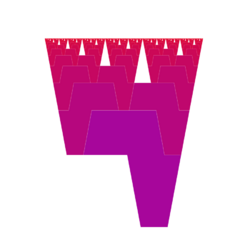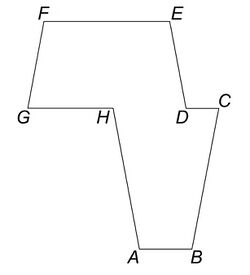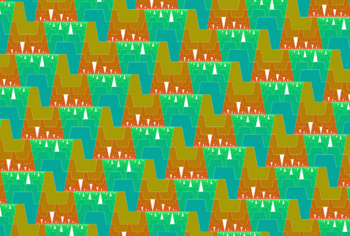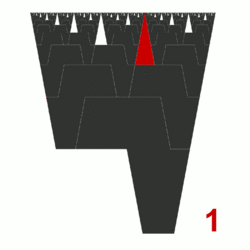Africa (fractal)
 From HandWiki - Reading time: 3 min
From HandWiki - Reading time: 3 min


Africa is a fractal made of a set of octagons that have some resemblance to the shape of Africa.[1][2][3] The number of octagons of different sizes in the fractal is related to the Fibonacci sequence: 1, 2, 3, 5, 8, 13, 21, .... The height of the largest octagon of the fractal is φ times longer than that of the second octagon; where φ is the golden ratio.[4][5][6]
Definition

The original version of the fractal was defined by the octagon with the following vertices:[7]
|
|
|
|
|
|
|
|
|
|
|
|
The following relations are obvious and necessary based on the shape of fractal:
where φ is the golden ratio. The fractal is made up of a countable number of copies of the octagon and its lateral inversion. The octagon has some resemblance to the shape of Africa:

Tessellation
The shape of the fractal can form the following tessellations:[8]
Properties
In the fractal, the number of octagons of each size (in order of size) is the Fibonacci sequence from the second term: 1, 2, 3, 5, 8, 13, 21, .... The number of isosceles triangles of each size (in order of size) is the Fibonacci sequence from the first term: 1, 1, 2, 3, 5, 8, 13, 21, ....[1]
References
- ↑ 1.0 1.1 Bellos, Alex (February 24, 2015). "Catch of the day: mathematician nets weird, complex fish". The Guardian. https://www.theguardian.com/science/alexs-adventures-in-numberland/2015/feb/24/catch-of-the-day-mathematician-nets-weird-complex-fish.
- ↑ Ouellette, Jennifer (February 28, 2015). "Physics Week in Review: February 28, 2015". Scientific American. https://blogs.scientificamerican.com/cocktail-party-physics/physics-week-in-review-february-28-2015/.
- ↑ Chung, Stephy (September 18, 2015). "Next da Vinci? Math genius using formulas to create fantastical works of art". CNN. http://www.cnn.com/2015/09/17/arts/math-art/.
- ↑ "Fractal Africa". The De Morgan Forum – London Mathematical Society. September 21, 2016. http://education.lms.ac.uk/2016/08/hamid-naderi-yeganeh-fractal-africa/.
- ↑ "Importing Things From the Real World Into the Territory of Mathematics!". HuffPost (blog). http://www.huffingtonpost.com/hamid-naderi-yeganeh/importing-things-from-the_b_8111912.html.
- ↑ Antonick, Gary (10 August 2015). "John Conway’s Wizard Puzzle". The New York Times. https://wordplay.blogs.nytimes.com/2015/08/10/feiveson-1/.
- ↑ Alexandre Borovik (2016-08-25). "Hamid Naderi Yeganeh: Fractal Africa" (in en). https://demorgangazette.wordpress.com/2016/08/25/hamid-naderi-yeganeh-fractal-africa/.
- ↑ Hamid Naderi Yeganeh, Africa-Fractal, http://archive.org/details/Africa-Fractal, retrieved 2022-06-23
 KSF
KSF






